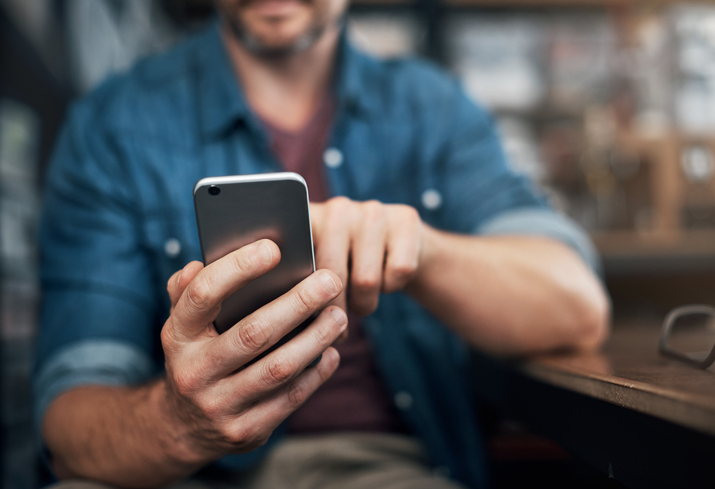You Love Streaming Your Favorite Shows
Here’s how to use less data doing so

YouTube, Netflix, Hulu, Amazon Prime – most people have a subscription to at least one of them and, thanks to the pandemic, plenty of people now subscribe to all three. It was a tough two years, spent mostly at home, alone, and in desperate need of entertainment. Music streaming services like Spotify, Pandora, and I Heart Radio also saw an uptick in subscribers, though not nearly as great as the movie streaming services. It’s like we’ve developed an addiction to being entertained which isn’t really a bad thing...

Though it could do some serious damage to your data.
Now if you have cell phone service with an unlimited data plan, you might not be too concerned about how much data you’re using. But think about it. If you have an unlimited data plan with up to 2GB of data or even 10GB of a data limit, once you hit that data cap, you’re going to care about how much data you’re using and be looking for ways to use less of it.
That’s where this post comes in. We're going to help you get the most out of your streaming service.
Let's start by looking at your current data usage
If you receive a paper bill from your internet service, the data usage information is most likely on the second or third page of your invoice. If your service provider doesn’t include it, you can call or go online to request a more detailed bill. You can also do the following:
-
Log into your account from your computer and check the Usage tab.
-
Download your provider’s app and check the Usage tab.
Call your provider from your wireless phone:
-
AT&T: Dial *3282#
-
T-Mobile: Dial #web#
-
Verizon: Dial #DATA
Make it a habit to check your data usage at least once a week so there aren't any home internet's data cap surprises at the end of the month. Or instead of having to regularly check your data usage, see if your internet provider allows you to set alerts to notify you when you've approached or exceeded your data limit.
Now let's look at how much data it takes to stream music from your favorite streaming service.

Honestly? Streaming music takes a lot less data than streaming say, Amazon prime video. Even among the most popular streaming services. Having said that though, it’s important to remember that most of us stream music on our smart phones and for a lot longer than we watch movies or videos. We’ve got our music streaming while we’re commuting, running on a treadmill, doing housework, etc. It all adds up to a lot of time listening via our cell phones – and those typically have a data cap. Sure, it might be a 10GB cap, but still.

Let’s take a moment to look at what you get in terms of hours with a 2GB, 5GB, or 10GB data plan. Generally speaking:
-
A 2 GB data plan will give you: 47 hours of low-quality audio, 28 hours of medium-quality audio, and 17 hours of high-quality audio.
-
A 5GB data will give you: 117 hours of low-quality audio, 70 hours of medium-quality audio, and 42.5 hours of high-quality audio.
-
A 10 GB data plan will give you: 234 hours of low-quality audio, 140 hours of medium-quality audio, and 85 hours of high-quality audio.
Obviously Spotify isn’t going to swallow up all your data that quickly, but listening to music for hours at a clip and on the highest-quality setting will definitely have an impact after a while.
So, what can you do?
Tips to reduce data usage on Spotify

1. For starters, remember that it’s always best to use Spotify via Wi-Fi. If you don’t have access to Wi-Fi, go into the app’s Data Saver feature and turn it on. This reduces the amount of data you’ll use by showing you fewer images and reducing the quality of the audio.
Click Home; click Settings; click Data Saver On
While you’re there, turn on Audio-only podcasts as well. This means that when you download a podcast, you won’t also be downloading its video, thus saving you data.
2.If you have Spotify Premium, download the music you like and enjoy it offline. Go into the app’s settings and under Music Quality, switch Download Using Cellular off and only download music when you’re connected to Wi-Fi.
3. Again, in the app, look at your Music Quality setting and make the necessary adjustments. The higher the audio quality setting, the more data you’re using.
4. It’s possible your smart phone has a data saver on it. A Google search on your specific device can help you find it and turn it on.
Moving on to popular streaming services and how much data they use

Services like Netflix, Hulu, and Amazon Prime all use about the same amount of data and, frankly, it’s a lot of data especially if you’re not using Wi-Fi. (Please, for the love of Pete, be on Wi-Fi when using these popular standard definition video streaming services!!) And as with music streaming services, movie and video streaming services allow you to adjust the video quality from high definition to standard definition.
Long sessions of streaming or streaming live TV often will cause a hike in data usage, and having an idea of how much data binge-watching uses will help keep you conscious of your monthly data limit.
Let’s take a look at Netflix as its data usage is comparable to that of Amazon Prime and Hulu.

How much data does streaming Netflix use? Netflix offers Low, Medium, and High streaming quality. Low uses 0.3 GB per hour, Medium (SD) uses 0.7 GB per hour, and ultra High definition (UHD) uses 3 GB per hour. Streaming TV shows or films on Netflix uses about 1GB of data per hour
That’s a lot of data so, again, please be on W-Fi and, if you’re thinking that downloading a movie from Netflix and watching it offline will save your data, it won’t. According to Netflix, it will still consume the same amount.
How much data does streaming YouTube use?

YouTube stacks up pretty closely to Netflix. In fact, 1GB of data allows you to watch just about 500 minutes of video content YouTube. You just probably shouldn’t do it in one fell swoop.
Generally speaking:
-
Video streaming a 480p video uses 264MB of data per hour.
-
Streaming a 720p video uses 870 MB of data per hour.
-
Streaming a 1080p video uses 1.65 GB per hour.
-
And streaming a 4K video uses 2.7 GB per hour.
This doesn’t look like a lot of data is being consumed and, because you’re an adult and rarely use YouTube, it probably isn’t. But what about your children or grandchildren? We could find some statistics that say “Young people are practically addicted to YouTube,” but we don’t need them. Because the fact is, kids are practically addicted to it.
Having said that, you might want to review their own data consumption and usage. After all, they’re probably plowing through their data cap on the daily.
How to check your data usage on YouTube

Android phones:
Go to Settings > Network & Internet connection > Mobile network. This will indicate how much data the kids are using in total. You can also go to “App Data Usage” to see how much data the YouTube app is using unto itself.
For iPhones:
Go to Settings > Cellular. Once you’re there, you can see how much data YouTube is using on the device. Under “Current Period” be aware that you might be seeing total data usage from several months (enough scare any mother or grandmother!) because that setting doesn’t refresh itself every month. For a clearer picture of how much data your kids or grandkids are using currently, scroll down and tap “Reset Statistics.” Hopefully that number will make you feel better!
If you’re a little stunned by the amount of data your family’s consuming watching sweet kitten videos or videos of cute puppies celebrating their birthdays with all their puppy pals, read on for ways to decrease and limit the amount data they’re using.
1. Embrace the joy of downloading.
If you’re a YouTube Premium customer – and if your family is on YouTube regularly it’s worth the expense to become one – you can download videos and watch them offline. This is one of the most effective ways to reduce your data usage.
2. Lower the quality of the videos you’re streaming
The higher the quality of the video, the more data it consumes. Adjust the quality down a notch and you’ll save significantly on your data usage. Here’s how:
In the video player:
Click “More” and it will give you the opportunity to adjust the quality of the videos you watch.
In your YouTube profile:
Log in and you can adjust the video quality for every video you watch.
3. Stream only while you’re on Wi-Fi!
We mentioned this earlier and it’s worth repeating. Watching YouTube videos via your home’s (or your local library’s or your favorite coffee spot’s) Wi-Fi connection will really help you stop draining away your data. You can also force the issue by going into your YouTube settings, finding the “Play HD on Wi-Fi only” option, and turning it on.
4. Nix autoplay
If you leave your YouTube account open and unattended, it will continue to play videos until you shut it off. To stop this and save some of your data, turn off autoplay. You can do so right from the screen of any video.
5. Say good-bye to cellular video streaming. streaming
To really conserve your data, you can disable the cellular streaming option. On an Android phone, swipe down on your phone and click Mobile Data. Once you’ve done that, you’ll be able to disable the cellular streaming. On an iPhone, go into Settings, select Cellular, and then switch Cellular Data to off.
6. Switch off muted playback
As you scroll through the feed of videos you’ve subscribed to, You Tube shows you snippets of those videos. The videos are muted, but they’re still draining your data. Simply go into your YouTube settings and switch the Muted Playback option to off.
That was a lot of information!

Honestly, I think we could talk about data all day. How much you need. How much you’re using. All the ways to cut back. We’ve covered a lot so let’s close with a couple of frequently asked questions you should be able to answer easily!
How much data does streaming a 2-hour movie take?
On average, watching a 2-hour movie at standard definition quality costs about 2GB of data.
How much data does streaming a 1-hour episode of your favorite show on Netflix, Hulu, etc. take?
On average, watching a 1-hour show at standard definition quality costs you about 1GB of data.
How many GB of data do you spend streaming over the course of a month?
On average, if you watched 2 episodes of your favorite show in standard definition quality, it would cost you about 60GB of data per month.
On average, if you streamed two hours of music at medium quality each day, it would cost you about 4.3GB of data per month.

Now that you’ve got the data business down, let us introduce you to a Government cell phone plan that gives you the service and data you need – for nothing.
Life Wireless offers government subsidized cellular services through the Affordable Connectivity Program to qualifying individuals and families. And, if you’re unemployed or participate in a government benefit program such as SNAP, Medicaid, Federal Public Housing Assistance, SSI, or WIC, you already qualify for this Federally-funded, no cost cellular service. As a participant, you receive the following, free, each month: Unlimited talk, text and data, and a free smartphone or you can bring your own.
Even if you’re paying just $20 a month for cell service, wouldn’t you rather have that $240 to spend on groceries, gas, or paying down debts? Of course you would. All it takes is just a few minutes to complete the application. Do so now, and you could be cutting your monthly cell phone bill to nothing in no time.
Plus, if you’re approved for Life Wireless/Lifeline Assistance Program and sign up for the Affordable Connectivity Program (ACP), you get two sources of free talk, text, and unlimited data that you can split between two phones. That means free cell service for you and free cell service for someone you love. If your child has been asking for a cell phone, this is a terrific opportunity to provide him or her with talk, text, unlimited data and the ability to stay in touch with you!
Of course you don’t have to split the service between two phones, you can keep it all on one. But it’s a wonderful option if your spouse, child or relative needs a phone – and who doesn’t? – but has been unable to get one due to the expense.
Whichever option you choose – to keep the data on one phone or split it between two – Life Wireless will make sure you receive the free talk, text, and unlimited data to help you stay connected.
Option 1: Combine Your Data
Activate Lifeline and ACP on the same device and receive unlimited talk, text, and data, plus 5GB of mobile hotspot.
Option 2: Split Your Data
Split your data between two phones or supported devices and you’ll have one device with ACP’s free talk, text, and 6GB of data and a second device with Lifeline’s talk, text, and 4.5GB of data (6GB of data in California).
Don’t wait. Get the service and data you need at no cost to you now!
Posted 1 year ago